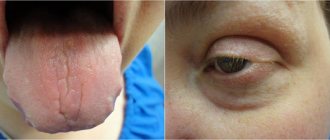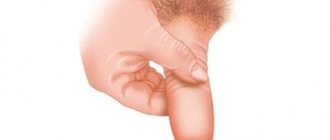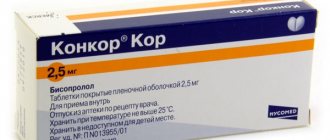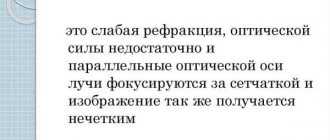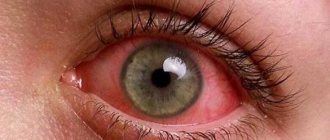Causes of lumboischialgia
People with excess weight, intervertebral hernias, chronic pathologies of the spine, and infectious exacerbations are primarily susceptible to the appearance of this syndrome. The risk group also includes production workers who are forced to bear heavy loads on the spine throughout the day, as well as people who work in one body position for a long time.
The causes of lumboischialgia can be very different, but in most cases it is a manifestation of lumbar spondyloarthrosis, disc herniation and other pathological changes in the spine. In older people, the cause of the disease is arthrosis of the hip joint, in which pain radiates to the lower back. Irritation of bone, ligamentous and muscle structures can also provoke pathology. In this case, patients are diagnosed with a bilateral pain reaction, the exact location of which is problematic to determine.
In neurology, it is also common to identify a number of factors that can contribute to the development of pathology. These include problems that arise with the spine: hypothermia of the spinal area, age-related changes and injuries. Chronic stress, pregnancy, poor posture, arthritis, and excessive sports and physical activity can accelerate the development of a painful syndrome.
Reasons for the development of lumbago with sciatica
Pain syndrome with lumboischialgia occurs as a result of nerve irritation, which is provoked by compression, injury or inflammation.
Lumboischialgia can be caused by protrusions and intervertebral hernias
The main causes of pathology are:
- scoliosis;
- arthrosis;
- osteochondrosis;
- protrusion, hernia;
- formation of osteophytes;
- osteoporosis;
- congenital anomalies of the spine;
- vascular diseases, which are characterized by impaired blood flow;
- abscesses, tumors in the lumbar region;
- hip joint injuries, muscle damage;
- diseases of internal organs (most often the development of tumors);
- rheumatism;
- failed epidural injections;
- postoperative complications;
- systemic connective tissue diseases;
- severe infectious pathologies that affect nerve trunks.
Provoking factors
Pain can be caused by prolonged exposure to an uncomfortable position.
Exacerbation of the pathology and the appearance of sharp, excruciating pain can lead to:
- improper lifting of weights;
- constant stress, long-term depression;
- awkward movements;
- obesity;
- prolonged stay in an extremely uncomfortable position;
- pregnancy;
- progression of degenerative processes caused by old age;
- hypothermia.
Pathogenesis of lumboischialgia
The pathogenesis of lumboischialgia is directly related to the cause that provoked it. For example, piriformis syndrome usually occurs with osteochondrosis, in which the area of the damaged intervertebral disc becomes a source of pathological impulses. In this case, the patient’s nervous system perceives such impulses as pain and does everything possible to eliminate it by increasing muscle tone or immobilizing the affected area. Muscle tension extends beyond the source of pain, affecting the piriformis muscle and the sciatic nerve. Due to muscle contraction, the nerve is compressed and pain occurs.
The cause of lumboischialgia can also be an intervertebral hernia, pathological processes in which lead to a narrowing of the lumen of the spinal column. This further leads to compression and inflammation of the sciatic nerve. As a result, motor and sensory nerve fibers are irritated, which provokes pain. Pain also appears as a result of severe hernia or its complications.
Symptoms of lumboischialgia
The following general symptoms are characteristic of lumboischialgia:
- limited mobility in the lumbar region;
- fixing the back in a position in which it is slightly bent forward;
- the occurrence of pain along the nerve during movements;
- a sharp increase in pain with a sudden change in body position;
- changes in the temperature and shade of the integument of the legs due to disruption of the blood supply process;
- severe pain when trying to stand on your leg;
- pain in the leg occurs mainly in the knee, buttock, and outer thigh;
- along the nerve there is often a feeling of heat, burning, itching or coldness;
- pain increases sharply with a cold, hypothermia, exacerbation of chronic diseases, overwork;
- stiffness of the lower back is observed when walking, scoliosis may occur;
- Minor's symptom is diagnosed - when changing position, the patient first turns over to the healthy side, after which he pulls up the sore leg.
Symptoms of lumboischialgia may differ depending on the form. In total, there are four forms of lumboischialgia:
- Musculoskeletal
- Neurodystrophic
- Neurovascular
- Neuropathic
The cause of this form of the disease can be an isolated muscular-tonic syndrome, which is vertebrogenic in nature. Pain impulses in this case are usually localized in the capsules of the intervertebral joints, receptors of the fibrous ring, capsules of the intervertebral discs. Often the cause of pain in the spine is pathology of the facet joints. In this case, the pain seems to affect the nerve roots and radiate to the leg, resulting in muscle spasm. Thus, the pain becomes the cause of muscle spasm, after which it intensifies.
The muscles are in a state of spasm, and the pain radiates to the leg, but does not reach the foot. The nature of the pain is significantly different from radicular pain, it is aching in nature, and also manifests itself in different intensities. Musculoskeletal lumboischialgia can also occur due to myofascial pain syndrome, which occurs in case of overload of previously untrained muscles, articular pathology, disease of the visceral organs, and developmental anomalies. Symptoms of the pathology are spasmed muscles and painful lumps in the muscles.
This form of pathology occurs against the background of a muscle-tonic reflex. Its most common manifestations are periarthrosis of the knee joint, localization of pain in the lower back and its subsequent movement to the knee joint. The main distinguishing signs of the pathology are severe lower back pain that has bothered the patient for several years, resistance to drug treatment, and the presence of damage to a large joint on one leg. A patient with this form experiences pathological changes in the joints. These changes affect large joints: knees, ankles, hips.
The development of pathology in most patients often occurs due to hypothermia. Patients experience chilliness, numbness in the left or right leg, pain, and a feeling of heaviness. During a clinical examination, the doctor diagnoses autonomic disorders, which are manifested by dry skin, changes in its color, and swelling in the lower leg area. Patients may also be diagnosed with pseudoendarteritis syndrome, which is characterized by pale fingers.
The main clinical manifestations of this type of disease include:
- shooting pains of a radicular nature, which radiate to the calf, thigh, buttock, foot, and also intensify with movement in the lumbar region;
- the presence of various symptoms of loss of a damaged root (loss or decrease in tendon reflexes, hypoesthesia, atrophy or muscle wasting with the formation of peripheral paresis).
Usually, to make an accurate diagnosis, the doctor does not focus solely on the presence of pain in the root area. A doctor can make a diagnosis if there are symptoms of prolapse of a damaged root. It should also be taken into account that this type of disease accounts for about 5% of cases.
Types and classification
Lumboischialgia is classified according to various criteria. So, according to the nature of the disease, it can be acute or chronic.
Based on the localization of the pathological process in tissues, the following types of manifestations of the disease are distinguished:
- musculoskeletal;
- neurodystrophic;
- neurovascular;
- neuropathic.
According to genesis, the pathology is:
- discogenic;
- spondylogenic;
- radicular.
Based on the type of lesion, bilateral and unilateral lumbar sciatica are distinguished.
Lumboischialgia can occur in several forms, each of which is classified according to different criteria.
According to the degree and nature of the spread of pain, the pathology can be unilateral (pain radiates to the buttock and leg on one side only) or bilateral, when the patient complains of pain in both extremities.
The pain may radiate to only one leg or both
According to the characteristics of the course, acute lumboischialgia is distinguished, which occurs for the first time, and chronic, which lasts longer than 12 weeks and is manifested by regular relapses under the influence of unfavorable factors.
The main classification of lumboischialgia is carried out according to pathogenetic features and development mechanism.
Types of lumboischialgia
| Variety | Characteristics and description |
| Muscular-tonic (myofascial). | The main cause of myofascial lumbar ischialgia is a violation of tonic muscle tension. The pathogenetic mechanism is based on muscle spasm, which leads to compression and pinching of blood vessels and nerve bundles, as well as disruption of blood and lymph circulation. Impaired muscle motility is typical not only for diseases of the musculoskeletal system, but also for pathologies of internal organs, for example, the digestive tract. |
| Neurodystrophic. | Neurodystrophic lumboischialgia is always a consequence of the myofascial form of the disease. The compressed root becomes inflamed, which leads to changes in trophic properties and disruption of the nutrition of nerve endings. The degeneration of nerve cells also contributes to compression of the blood vessels through which the nerve endings receive the nutrients necessary to regulate neuromuscular transmission. |
| Vegetative-vascular. | In this form, lumboischialgia is combined with acute circulatory disorders in the vessels of the distal part of the spine and lower extremities, which is clinically manifested by severe paresthesia (numbness, tingling), as well as a feeling of heat or chills in the lumbar region. |
Separately, neurosurgeons identify a vertebrogenic form, which develops against the background of diseases of the spine (vertebrogenic means “coming from the spine”). These can be both pathologies of the intervertebral discs and degenerative changes in the bone structures and joints of the spine. Treatment of vertebrogenic lumboischialgia is impossible without correction of the underlying disease.
Lumboischialgia can be right-sided when the nerve to the right of the spine is inflamed, left-sided when the nerve is damaged on the left, and bilateral. Pinching a nerve on both sides at once is extremely rare.
According to the nature of the course, lumboischialgia can be acute or chronic. The transition to the chronic stage is indicated by the duration of the disease for more than three weeks and regular exacerbations.
What is sciatica
- myofascial, or muscular-tonic. The reason is persistent tonic muscle tension and spasms, which cause compression of nerve bundles and blood vessels, and also disrupt lymph and blood flow. This state of the muscular system is characteristic not only of pathologies of the musculoskeletal system, but also of diseases of internal organs - in particular, the gastrointestinal tract;
- neurodystrophic. This is always a consequence of myofascial disorders: when a nerve root is pinched, its nutrition is disrupted due to compression of the vessels. Blood flows to the nerve in insufficient volume, nerve cells are depleted, which leads to a failure in the regulation of neuromuscular transmission;
- The vegetative-vascular (angiopathic) mechanism of lumboischialgia is caused by impaired circulation in the pelvis and lower extremities. Clinically, this is manifested by a sensitivity disorder - a feeling of tingling, burning, coldness or numbness in the lumbar area and the back of the thigh.
- the vertebrogenic type develops in diseases of the spine - osteochondrosis and its consequences in the form of hernias, spondyloarthrosis, etc. The prefix "vertebro" literally means "vertebra", therefore any pathology with damage to the vertebral structures will be called vertebrogenic, or vertebral.
REFERENCE: vertebral lumboischialgia can also be called spondylogenic - these two terms are synonymous, but differ in origin. Vertebra is a Latin word, and Spondilos is a Greek word. Both of them are translated as "vertebra". There is also a narrower concept of discogenic lumboischialgia, which occurs when an intervertebral disc is displaced.
Diagnosis of lumboischialgia
Diagnosis of lumboischialgia begins with a clinical examination of the patient. During the examination, the doctor conducts a dynamic and static examination of the spine, checks the condition of the sciatic nerve, and identifies signs of tumors or infection. The main symptom of the disease, which a neurologist necessarily pays attention to, is a sharp increase in pain upon palpation of the exit point of the sciatic nerve to the thigh. During the clinical examination, the abdominal and pelvic organs are additionally examined.
The most accurate instrumental method for diagnosing pathology is considered to be radiography of the lumbar region. With its help, it is possible to detect a decrease in the height of the intervertebral discs, hypertrophy of the articular processes, sclerosis of the end plates, and uneven narrowing of the spinal canal.
Treatment of lumboischialgia
Neurologists and vertebrologists are involved in the diagnosis and treatment of the disease. Therapeutic measures to eliminate back pain are carried out against the background of the fight against the causes that caused it (hernia, osteochondrosis). If the disease has an acute course, the patient must be provided with high-quality bed rest: his bed should be elastic and hard. To relieve pain, your doctor may prescribe analgesics. In case of severe pain that cannot be eliminated, they resort to blockades - injections with an anesthetic directly into the source of pain. Patients with lumbar ischialgia are also advised to use local irritating procedures: rubbing, distraction techniques, pepper patch.
In the acute phase of the disease, the patient is prescribed the following groups of drugs:
- Muscle relaxants to eliminate muscle spasms (sirdalud, mydocalm, baklosan).
- Novocaine blockades are injected into the spinal area to eliminate extremely severe pain, from which conventional painkillers (diprospan, hydrocortisone) do not help.
- Diuretics to relieve swelling of nerve trunks (Lasix).
- B vitamins are prescribed to improve the conductivity of nerve roots, as well as restore muscle fibers (milgamma, neuromultivitis).
- Sedatives (Relanium, phenazepam, tranquilizers, sleeping pills).
- Blood circulation activators (actovegin, trental, aminophylline).
Physiotherapy will be an addition to the therapeutic treatment of lumboischialgia: therapeutic sleep, acupuncture, mud baths, massage, manual therapy. In this case, the most effective method of eliminating pain is considered to be therapeutic massage, during which special attention is paid to the effect on the sacrum and lumbar region. Systematic massage of this area allows you to activate and improve blood flow, slow down the development of the disease, and restore metabolism in the spinal column.
If drug therapy and physical therapy do not work and the pain intensifies, then surgery is prescribed. Indications for surgery: serious pelvic disorders, severe pain, compression of the spinal cord, lower paraparesis. In most cases, surgical treatment of intervertebral hernias is performed, during which the damaged discs are partially or completely removed. According to indications, discectomy, endoscopic discectomy, and microdiscectomy may also be prescribed.
To reduce pain and prevent possible relapses, patients are advised to undergo a course of therapeutic exercises. This course of exercises is aimed at strengthening the muscles that surround the spinal column, thereby reducing the risk of vertebral displacement and making them more resistant to stress. Patients should perform exercises in specialized institutions under the supervision of specialists. However, over time, after completing a course of physical therapy, they will be able to continue their activities at home on their own.
The complex of therapeutic gymnastics necessarily includes exercises that help stretch the muscles (turning the body, bending, bending the back). Exercises aimed at restoring the mobility of the hip joints and spine (squats, leg swings, lifting the body from a lying position) are also considered effective. Patients are also recommended to engage in exercise equipment and yoga.
Forecast
The prognosis is favorable with timely treatment of vertebral pathology (spine) and lumbodynia. At home, it is not recommended to get rid of the disease using untested medications or folk remedies. If you experience burning pain (right or left) in any part of the spine, it is recommended to consult a doctor. If symptoms are severe and persistent (bilateral pain on the left or right side), you need to call an ambulance, as injections will be required.
Advice! It is not recommended to do gymnastics and other exercises without the knowledge of a doctor. Only after differential diagnosis and prescription of the necessary pills that reduce the manifestations of the disease (moderate pain) can you play sports. You can’t start exercise suddenly. Only a doctor can treat the disease.
Similar:
- The main symptoms of a hernia of the thoracic spine, the causes of the disease, methods of diagnosis and treatment
- Causes of lumbar spinal hernia, prevention of complications, treatment methods for acute pain and symptoms
- The effectiveness of fitness for hernia of the lumbar spine, the causes of pathology, the rules of exercise therapy and general recommendations
- Symptoms of a pinched sciatic nerve, causes and treatment at home, prevention and prognosis
- Methods of treating intervertebral hernia of the lumbar spine without surgery, symptoms of the disease, complications and preventive measures
- Causes of development of sequestered spinal hernia, symptoms, diagnosis, treatment methods and possible complications
- Features of treatment of hip bursitis, symptoms, methods of prevention, complications, prognosis and complications of the disease
Forecast and prevention of lumboischialgia
In most cases, the pathology is benign and has a favorable prognosis. However, poor and untimely treatment, as well as relapses, can lead to disruption of metabolic processes, tissue deformation and the formation of knots deep in the muscles.
Neurology has developed a whole range of preventive measures to prevent the disease. First of all, it is necessary to promptly treat spinal pathologies and prevent their development.
Neurologists also strongly recommend refraining from prolonged stress on the spine, which leads to its pathological changes. When performing physical exercises, you should avoid straining untrained muscles, and also try to form the correct muscle corset. Patients should strengthen correct posture, monitor their weight, and avoid bad habits. If you follow all these recommendations, you can prevent the disease or eliminate the risk of its relapse.

